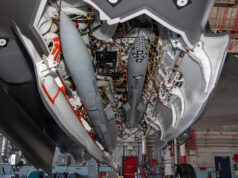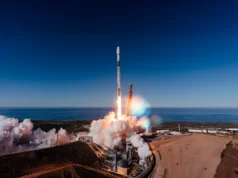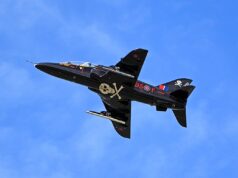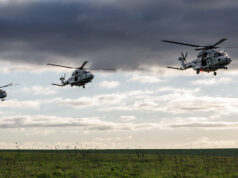The total cost of British operations against Islamic State has been revealed.
Jim Cunningham, MP for Coventry South, asked in a Ministry of Defence written question:
“To ask the Secretary of State for Defence, what recent estimate he has made of the cost to the public purse of the fight against Daesh.”
Mark Lancaster, The Minister of State at the Ministry of Defence, replied:
“The net additional cost of counter-Daesh operations in Financial Year 2017-18 was £583.1 million.”
Additional costs in previous years are as follows:
By September 2017, the Ministry of Defence had announced that over 1,000 personnel were engaged in theatre and that the Royal Air Force had conducted around 900 airstrikes, flying over 2,200 sorties, killing 3,000 Islamic State fighters.
Last year, it was reported that the Royal Air Force is operating at its most intense for 25 years in a single theatre of operation which far outstripped the UK involvement in Iraq and Afghanistan – RAF jets have dropped 11 times more bombs (1,276 strikes) on Syria and Iraq in the preceding 12 months than they had in the busiest year of action in Afghanistan a decade previously.
As of April 2017, 37 Hellfire missiles, 20 Brimstone missiles, 30 unspecified/other armaments were used in the operation against Islamic State in Iraq and Syria.















As long as our personnel are safe and we have lost nobody that’s the important thing. 🙂
One British serviceman was sadly killed earlier this year in Manbij.
Oh dear. 🙁
Are you joking? Of course they are not safe, since when has war been safe? It’s ininherently unsafe, that’s why it’s called war and why you mitigate against the risk of harm and death.
Wow-3 extra Type 31’s plus running costs for a while? On the other hand-doing our bit for the fight against the ISIS evil empire. Do we shoulder a disproportionate burden of this conflict?It seems our EU partners France being the exception, get off pretty scot free.
No change there then.
To be fair most EU forces are primarily defensive in nature: relatively big on numbers of troops and combat vehicles, but very few assets to enable expeditionary operations without deploying as part of NATO. It’s part of why our military looks so relatively smaller compared to a lot of our allies: we have a FAR bigger focus on actually using our forces
No wonder the Germans are so much wealthier than we are.
Op Shader has probably realistically helped the integration of ground attack munitions and live firing on typhoon no end!
Maybe its about time Nato members put some money into a pot and those that actually go on operations use it.
Many of the European nations are really taking the US and UK for granted whilst not being very collegiate in their approach to us.
How about a fee for NATO membership as a percentage of GDP, no expectation for how much you spend on your military as it is now.
If military action is required, that money is used to cover the costs for which ever nation has the ideal or best placed capability. Membership money left over is used for R&D to develop NATO only capabilities and new common platforms which members can then buy. Builds are shared out based on contribution level, but done in a way that benefits everyone’s industry , job creation and know how.
Worth every penny. No fate is too unpleasant for those savages.
467,000 per man with AK. Perhaps we need to follow US and go for cheaper aircraft. Advanced hawk?
Tucano is the evergreen favorite suggestion for a low cost counter insurgency platform. The RAF even has 51 Short Tucano as trainers, albeit without under-wing hard-points. However I suspect the large proportion of the costs are in ordnance.
In 2015 and 2016 it seems the UK spent £400M on Paveway IV alone. Brimstone and Paveway IV apparently cost somewhere around £70k-£100k each so with the intensity of operations and strikes since its perhaps not that surprising how costs add up.
The cost is the cost. When we agreed in parliament to commit the RAF to attacking ISIS then it was obvious the campaign would be costly. We are striving very hard to avoid collateral civilian casualties. Thus very advanced precision munitions are needed.
Then there is the flying hours costs of typhoon and tornado+ deployment support costs RAF ground crew, wages, logistics, RAF regiment defence for RAF Akritoro.
All adds up. Unfortunately it does mean each ISIS fighter known to have been killed has cost nearly £500k.
High performance jets however were needed in Syria because of the presence of Syrian airforce migs and sukhois and then there is the complication of Russian S400 SAMs and Airforce being present. Tucanos would be flying coffins against these systems and ISIS known MPSAMs.
Can’t help but think this is a waste of money. Dropping expensive bombs isn’t going to change anything. As history tells us no war was ever won in the air! Is this going to be a case of a long term conflict which ends in the two sides talking perhaps in 2025? The taliban being the example.
And yet Daesh is crumbling.
This isn’t the same as Afghanistan and the Taliban though. The missions are specifically against ISIS, not against one or more of the multitude of other factions in Syria. We might not like Assad but we’re not prosecuting attacks against him outside responses to chemical weapon use, which are distinct and separate actions. In my view, “winning” against ISIS is more likely to look like keeping them weak, in order to help undermine their ability to prosecute attacks against targets in Europe and elsewhere, than an ability to win in any conventional sense.
Someone, somewhere in a position of authority is persuaded this is a worthwhile risk for our people and a use of our funds. But then, the same could be said about Suez, or Iraq. I wonder how much is about an inability to loose face by climbing-down from an entrenched anti-Assad position & ceding the field to Russia, and how much is about actually influencing the course of events. I for one believe that Assad is hideous but guess what? So are the opposition we are supporting. I just don’t know any more what the point is. Were we to be losing lots of people, there would be more scrutiny but as it is, only specialist websites like this even know this is still happening. 1.4 bln would have been better spent rebuilding the country and averting a refugee/ immigration crisis. Or, if that doesn’t float your boat, how about 1.4 times the recent (much vaunted) ‘increase’ in your the defence budget. The vote in Parliament felt right at the time but now? Time to leave.
My comment from March 2018.
https://ukdefencejournal.org.uk/cost-british-air-operations-iraq-syria-reach-1-75-billion/#comment-402599
This doesn’t include the cost of AAR aircraft, nor the cost of repairing all the damage we have done, nor the wear and tear on airframe life. But at least the RAF have proved to ministers that they need this extra £1.7bn every 3 years and that pointy fast shiny jets with expensive bombs are more important than Escort Ships or Royal Marines or CAMMs on our QEs.
Given that most of the targets were unarmoured and soft targets this whole operation would have been about £1.4bn cheaper if we had exclusively used Reaper and LMM.
Worth every penny. Keep pounding them lads and lasses. Doing us proud
My own thoughts are that over the same time period U.K. payments of compensation and statutory benefit support to returning I.S.I.S. fighters and their families will exceed this figure. But, then, we will never know because we won’t be told.